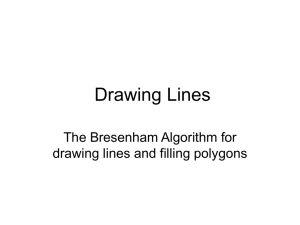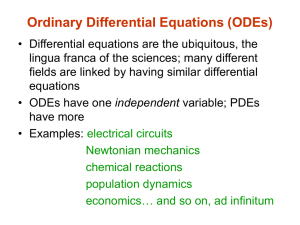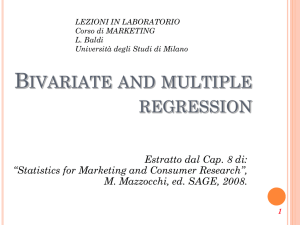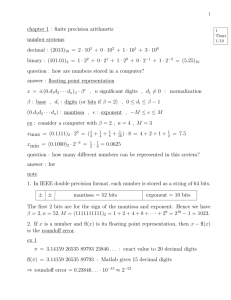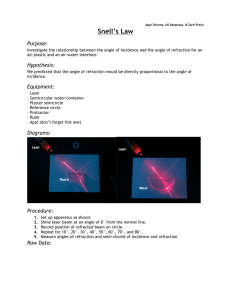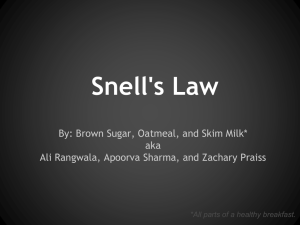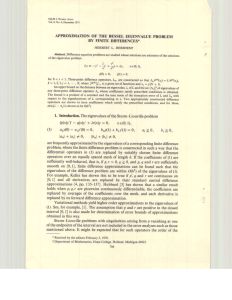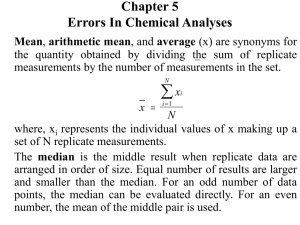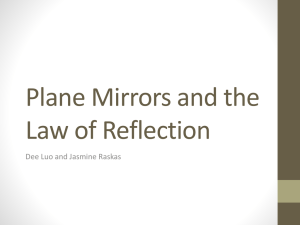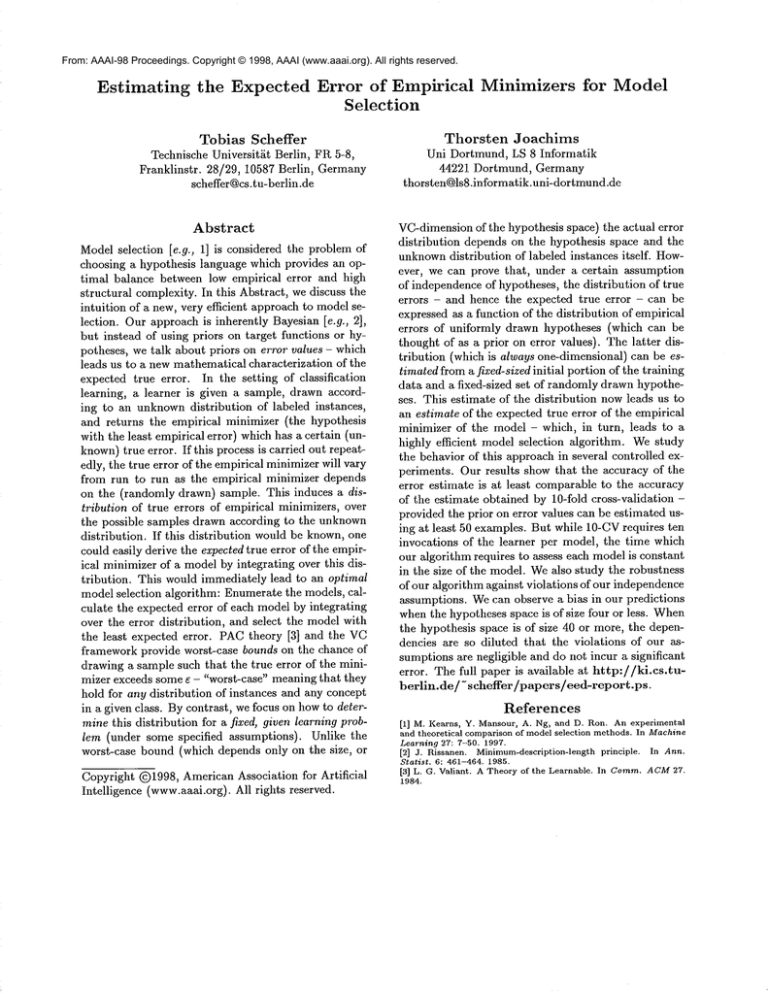
From: AAAI-98 Proceedings. Copyright © 1998, AAAI (www.aaai.org). All rights reserved.
Estimating
the Expected
Error of Empirical
Selection
Tobias Scheffer
Technische Universit~t Berlin, FI~ 5-8,
Franklinstr. 28/29, 10587 Berlin, Germany
scheffer@cs.tu-berlin.de
Abstract
Modelselection [e.g., 1] is considered the problemof
choosing a hypothesis language which provides an optimal balance between low empirical error and high
structural complexity. In this Abstract, we discuss the
intuition of a new, very efficient approachto modelselection. Our approach is inherently Bayesian [e.g., 2],
but instead of using priors on target functions or hypotheses, we talk about priors on error values - which
leads us to a newmathematical characterization of the
expected true error. In the setting of classification
learning, a learner is given a sample, drawn according to an unknowndistribution of labeled instances,
and returns the empirical minimizer (the hypothesis
with the least empirical error) whichhas a certain (unknown)true error. If this process is carried out repeatedly, the true error of the empirical minimizerwill vary
from run to run as the empirical minimizer depends
on the (randomly drawn) sample. This induces di stribution of true errors of empirical minimizers, over
the possible samples drawn according to the unknown
distribution. If this distribution would be known,one
could easily derive the expected true error of the empirical minimizerof a modelby integrating over this distribution. This would immediately lead to an optimal
model selection algorithm: Enumeratethe models, calculate the expected error of each model by integrating
over the error distribution, and select the model with
the least expected error. PACtheory [3] and the VC
frameworkprovide worst-case bounds on the chance of
drawinga sample such that the true error of the minimizer exceeds somee - "worst-case" meaningthat they
hold for any distribution of instances and any concept
in a given class. By contrast, we focus on howto determine this distribution for a fixed, given learning problem (under some specified assumptions). Unlike the
worst-case bound (which depends only on the size, or
Copyright @1998,American Association for Artificial
Intelligence (www.aaai.org). All rights reserved.
Minimizers
for Model
Thorsten
Joachims
Uni Dortmund, LS 8 Informatik
44221 Dortmund, Germany
thorsten@ls8.informatik.uni-dortmund.de
VC-dimensionof the hypothesis space) the actual error
distribution depends on the hypothesis space and the
unknowndistribution of labeled instances itself. However, we can prove that, under a certain assumption
of independenceof hypotheses, the distribution of true
errors - and hence the expected true error - can be
expressed as a function of the distribution of empirical
errors of uniformly drawn hypotheses (which can be
thought of as a prior on error values). The latter distribution (which is always one-dimensional) can be estimated from a fixed-sized initiM portion of the training
data and a fixed-sized set of randomlydrawn hypotheses. This estimate of the distribution nowleads us to
an estimate of the expected true error of the empirical
minimizer of the model - which, in turn, leads to a
highly efficient model selection algorithm. Westudy
the behavior of this approach in several controlled experiments. Our results show that the accuracy of the
error estimate is at least comparable to the accuracy
of the estimate obtained by 10-fold cross-validation provided the prior on error values can be estimated using at least 50 examples. But while 10-CVrequires ten
invocations of the learner per model, the time which
our algorithm requires to assess each modelis constant
in the size of the model. Wealso study the robustness
of our algorithm against violations of our independence
assumptions. Wecan observe a bias in our predictions
whenthe hypotheses space is of size four or less. When
the hypothesis space is of size 40 or more, the dependencies are so diluted that the violations of our assumptionsare negligible and do not incur a significant
error. The full paper is available at http’//ki.cs.tuberlln.de/scheffer/papers/eed-report.ps.
References
[1] M. Kearns, Y. Mansour, A. Ng, and D. Ron. An experimental
and theoretical
comparison of model selection methods. In Machine
Learning 27: 7-50. 1997.
[2] J. Rissanen. Minimum-description-length
principle.
In Ann.
Statist.
6: 461-464. 1985.
[3] L. G. Valiant.
A Theory of the Learnable.
In Comm. ACM27.
1984.

